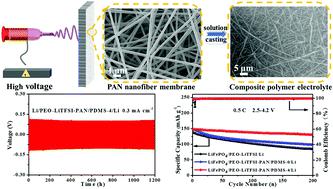Our official English website, www.x-mol.net, welcomes your feedback! (Note: you will need to create a separate account there.)
A 3D polyacrylonitrile nanofiber and flexible polydimethylsiloxane macromolecule combined all-solid-state composite electrolyte for efficient lithium metal batteries.
Nanoscale ( IF 6.7 ) Pub Date : 2020-06-11 , DOI: 10.1039/d0nr04244g Lu Gao 1 , Jianxin Li 2 , Bushra Sarmad 3 , Bowen Cheng 2 , Weimin Kang 1 , Nanping Deng 2
Nanoscale ( IF 6.7 ) Pub Date : 2020-06-11 , DOI: 10.1039/d0nr04244g Lu Gao 1 , Jianxin Li 2 , Bushra Sarmad 3 , Bowen Cheng 2 , Weimin Kang 1 , Nanping Deng 2
Affiliation

|
All-solid-state polymer electrolytes have received widespread attention due to their superior safety over liquid electrolytes that are prone to leaks. However, poor ionic conductivity and uncontrollable lithium dendrite growth have greatly limited the rapid development of polymer electrolytes. Hence, we report a composite polymer electrolyte combining a polyacrylonitrile (PAN) electrospun fiber membrane, flexible polydimethylsiloxane (PDMS) macromolecules and a polyethylene oxide (PEO) polymer. The introduction of PDMS with a highly flexible molecular chain, ultra-low glass transition energy and high free volume can help optimize lithium ion migration paths and improve the interface compatibility between the electrolyte and the electrode. In addition, the nano-network structure of the PAN nanofiber membrane can promote the interaction between adjacent polymer molecular chains and improve the mechanical properties of the composite electrolyte to suppress the lithium dendrite growth. The synergistic effect of the PDMS and PAN electrospun nanofiber membranes endows the composite electrolyte with superior ionic conductivity and excellent electrochemical stability towards lithium metal. The interface impedance of the Li/Li symmetric battery with the composite electrolyte after 15 days of continuous standing has no significant change compared with the initial state, and the battery can maintain stable cycling for 1200 h without short circuit under a dynamic current of 0.3 mA cm−2. The obtained composite polymer electrolyte has potential application prospects in the field of high-energy lithium metal batteries.
中文翻译:

一种3D聚丙烯腈纳米纤维和柔性聚二甲基硅氧烷大分子相结合的全固态复合电解质,可用于高效锂金属电池。
全固态聚合物电解质由于其比易于泄漏的液体电解质优越的安全性而受到广泛关注。然而,差的离子电导率和不可控制的锂枝晶生长极大地限制了聚合物电解质的快速发展。因此,我们报告了一种复合聚合物电解质,该电解质结合了聚丙烯腈(PAN)电纺纤维膜,柔性聚二甲基硅氧烷(PDMS)大分子和聚环氧乙烷(PEO)聚合物。引入具有高度柔性的分子链,超低玻璃化转变能量和高自由体积的PDMS可以帮助优化锂离子迁移路径,并改善电解质与电极之间的界面相容性。此外,PAN纳米纤维膜的纳米网络结构可以促进相邻聚合物分子链之间的相互作用,并改善复合电解质的机械性能,从而抑制锂枝晶的生长。PDMS和PAN电纺纳米纤维膜的协同作用使复合电解质具有优异的离子电导率和对锂金属的出色电化学稳定性。连续放置15天后,Li / Li对称电池与复合电解质的界面阻抗与初始状态相比没有显着变化,并且在0.3 mA的动态电流下,该电池可以在没有短路的情况下保持1200 h的稳定循环厘米−2。所得复合高分子电解质在高能锂金属电池领域具有潜在的应用前景。
更新日期:2020-07-09
中文翻译:

一种3D聚丙烯腈纳米纤维和柔性聚二甲基硅氧烷大分子相结合的全固态复合电解质,可用于高效锂金属电池。
全固态聚合物电解质由于其比易于泄漏的液体电解质优越的安全性而受到广泛关注。然而,差的离子电导率和不可控制的锂枝晶生长极大地限制了聚合物电解质的快速发展。因此,我们报告了一种复合聚合物电解质,该电解质结合了聚丙烯腈(PAN)电纺纤维膜,柔性聚二甲基硅氧烷(PDMS)大分子和聚环氧乙烷(PEO)聚合物。引入具有高度柔性的分子链,超低玻璃化转变能量和高自由体积的PDMS可以帮助优化锂离子迁移路径,并改善电解质与电极之间的界面相容性。此外,PAN纳米纤维膜的纳米网络结构可以促进相邻聚合物分子链之间的相互作用,并改善复合电解质的机械性能,从而抑制锂枝晶的生长。PDMS和PAN电纺纳米纤维膜的协同作用使复合电解质具有优异的离子电导率和对锂金属的出色电化学稳定性。连续放置15天后,Li / Li对称电池与复合电解质的界面阻抗与初始状态相比没有显着变化,并且在0.3 mA的动态电流下,该电池可以在没有短路的情况下保持1200 h的稳定循环厘米−2。所得复合高分子电解质在高能锂金属电池领域具有潜在的应用前景。


























 京公网安备 11010802027423号
京公网安备 11010802027423号